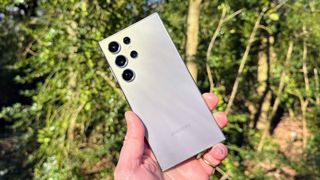I can’t believe I love this downgrade from the Samsung Galaxy S24 Ultra
As I’ve gotten older, I’ve developed an appreciation for simple and refined design that eschews the flair for practicality. And the Samsung Galaxy S24 Ultra is a good example of this.
Galaxy Ultra models and their Galaxy Edge predecessors have been shipping with curved edges on their displays for years. Over the years, refinements to display panels have led to gently curved edges that make for highly usable, bezel-less screens. And curved screens came to the likes of Google Pixel phones and flagship OnePlus models.
But like the Google Pixel 8 Pro, the Galaxy S24 Ultra has ditched the curved edges of its predecessors in favor of flat screen edges. Normally I consider this an unpleasant downgrade; What can I say, I love curves.
There’s always been something pleasing about seeing a screen that flows neatly into the phone’s chassis, as they’ve always felt a bit sci-fi to me – along the lines of Star Trek instead of the rough aesthetic of Star Wars’ galaxy far, far away. And it generally makes a phone feel quite comfortable in the hand, although you do indeed have to hold it, as curved screens lead to slippery phones, especially on the larger screen sizes of 6.7 inches and plus.
So with the Galaxy S24 Ultra, I was fully prepared to turn my nose up at its lack of curves. But I didn’t. Instead, I’m quite impressed with this change.
Samsung said it dropped the curved screen to give the S Pen more practical screen real estate for people to scribble on. And I found this to be the case, with long strokes of the stylus sticking to the screen rather than sliding off the curved edges as was the case with the Galaxy S23 Ultra.
I thought a flat screen would make the Galaxy S24 Ultra uncomfortable to hold, but that’s not the case.
The curved titanium sides with a slightly soft finish make the large phone feel unexpectedly comfortable in my hands, while also making it less likely to jump out of hand when I stretch my fingers to reach for one in the top corner. handed over.
I also think using Corning’s new Gorilla Glass Armor will work well on a flat screen rather than a curved one.
I would have liked to see titanium used to make the Galaxy S24 Ultra significantly lighter than its predecessor, but that’s not the case: it only weighs a gram in total. But in my hands, the Galaxy S24 Ultra simply feels superior to the Galaxy S23 Ultra, a phone that I still think has a beautiful design.
The matte back of the Galaxy S24 Ultra, which has layers of paint that provide a smooth finish that also feels quite deep (this may sound a bit nonsensical, but I recommend that you check out a Galaxy S24 Ultra for yourself), a nice addition to the flat screen and the curved edges.
Overall, these small tweaks may seem iterative, but together they add up to a phone that looks and feels like a step up from the Ultras that came before it.
Of course, there’s plenty more to like about the phone, as you’ll see in our Samsung Galaxy S24 Ultra review. These range from a refined rear camera suite to AI features that are promising, even if not yet perfect.
Aside from tweaking the software experience, which in my opinion is still a weak point of Samsung phones due to the plethora of menus and One UI-focused apps, and beefing up AI smarts, it’s hard to see how Samsung will improve the design of the Galaxy. Ultra line. I guess we shouldn’t be surprised that Samsung has now used the same general design for three generations of Galaxy Ultras.




